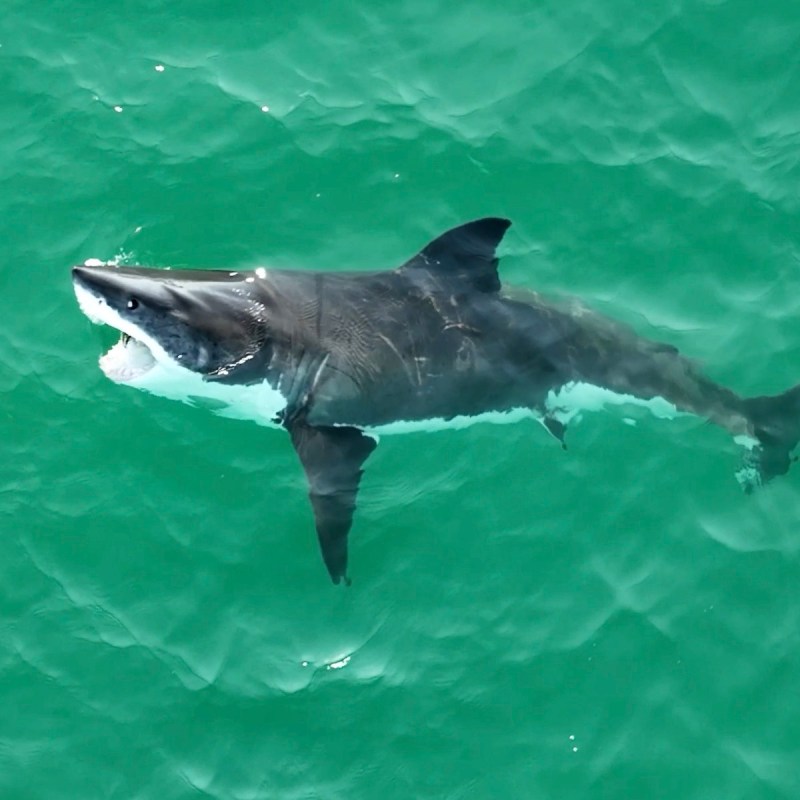
Just when you thought it might be safe to go into the water, a new study of juvenile great white sharks shows they may be closer to you than you think — a lot closer!
Videos by TravelAwaits
Results of a riveting new study created by California State University Long Beach’s Shark Lab documented just how close and how often juvenile great white sharks are swimming next to swimmers and surfers. The hair-raising data shows that these people didn’t even realize that an apex predator may only be a few feet away!
Massachusetts has been in the news lately, with many adult great white shark sightings. Now, southern California has just become known as a “hotspot” because of a super-shark highway running up and down the coast with many juvenile great whites.
The Study
The Shark Lab conducted a 2-year research study utilizing aerial drones to video and photograph juvenile great whites at 26 beaches along the West Coast from Santa Barbara county down to San Diego. The study was published in the PLOS journal. A great white is considered a “juvenile” from birth to about 6 years old and can measure up to 8 or 9 feet long. The Shark Lab’s findings were pretty shocking to most who viewed the data.

The Sharks Are So Close To People
Surprisingly, most people were not aware how many sharks were in the water and how close they were to people in the ocean. Over 1,500 drone flights were recorded with 97 percent of them showing juveniles swimming close to surfers and swimmers. The study also determined there are two hotspots of activity. Currently, Carpinteria near Santa Barbara and Del Mar Beach in San Diego are the two locations of heavy aggregations of juveniles. The study showed that in the aggregation areas, up to 20–50 sharks may be swimming next to people! Most of the time, the people in the water didn’t even know the sharks were there, according to the report. The location of these hot spots (“aggregation areas”) will ebb and flow in the future.
Their Favorite Food
Juveniles like warm water and the safety of shallow areas for protection and access to their favorite food: sting rays on the shore line. Warm, shallow waters are nurseries for great whites. Once the shark develops into an adult, its desire for prey changes and they migrate to deeper, cooler waters. One of the staples and prime delicacies for adult great whites are seals. Seals are abundant in California’s coastal waters. They became protected in 1972 and their population has since exploded. Where you have seals, you have great whites.
One of the big questions is “Where will the next hot spot be?” The data shows that if the swimmers and surfers don’t bother or pester the juveniles, the odds of being bitten are greatly reduced. The good news is, with all the data collected, no shark bites occurred during this 2-year study. However, the researchers don’t know where the next aggregation site might move, be it up or down the coast. It is a completely different situation with adult great whites who transit our beaches looking for food.
The Malibu Artist
The most notable and prolific drone pilot, with his eye in the sky, is The Malibu Artist, Carlos Gauna. He has captured stunning images of sea life in our southern waters but is probably best known for his images of the stellar great white in its natural habitat. I spoke with Gauna and he shared his goals and thoughts about people and sharks coexisting. Gauna’s motto is to respect and observe wildlife from afar, implement keystone changes by bringing awareness back to observing the animals, and not interacting with them, which ultimately would change their behavior.
Gauna says, “It’s important to observe animals without any interference. Respect the animals.” He hopes the videos he posts on his YouTube channel and social media platforms will bring shark awareness and conservation, and continue to champion the sharks behavior naturally and not be disturbed by humans.

Changes
One change that Gauna would like to see is similar protection rules that whales have but not sharks. Whale watching tours must maintain a certain distance from the whales and not impede its course in the water. However, when it comes to sharks, people can swim, snorkel, and “redirect” the shark by touching it on the nose. This human interaction alters the animals natural behavior. People nowadays do ridiculous things near wild animals, for social media, and might forget that the juvenile great white is an apex predator and can react and the consequences might be dire!
If you see a shark in the water:
- Don’t Panic!
- Don’t splash and retreat slowly backwards to the shore facing the shark.
- Don’t swim alone.
- Don’t swim early in the morning or late at night, or in murky water.
The results of this data have certainly given me pause. I live in southern Orange County, California, and my two daughters surf in our local waters. When I was a kid, I saw the movie Jaws and I have been affected by it ever since 1974! I think, generationally, it has affected us as a group to think of the great white as an opportunistic, stealthy killer of all creatures and people in the ocean. As a typical parent, I get concerned and honestly my thoughts can drift to the deep edge of worry when I think of my girls in the water. I am relieved when I think about the data and the reality that the sharks have always been there, and attacks are extremely rare.
For more travel news, check out these recent articles:
